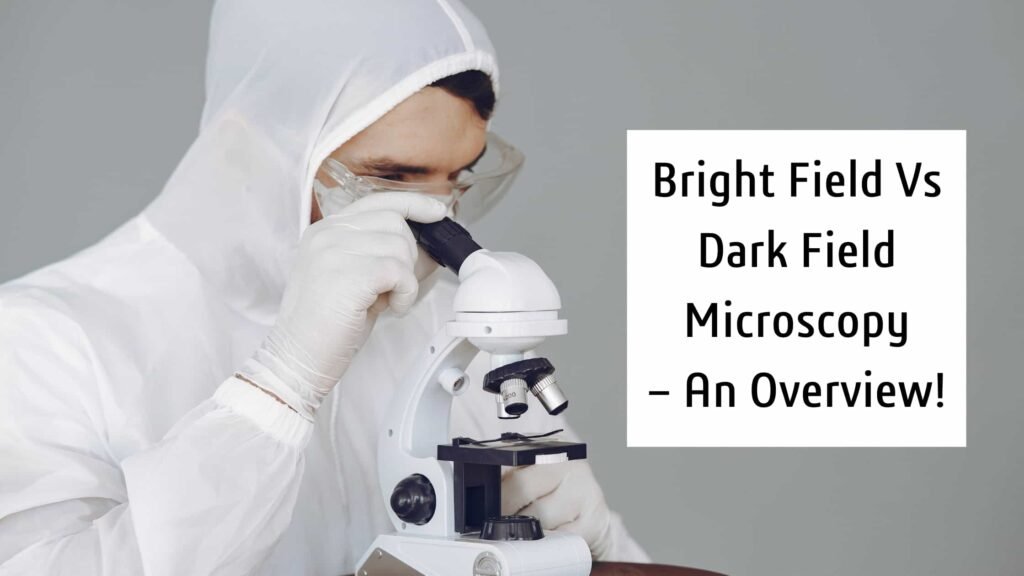What are darkfield and brightfield microscopy? It’s like something out of a star wars movie! Unfortunately, neither grants us unique abilities. That doesn’t negate the fascination with darkfield and brightfield microscopy.
In light microscopy, contrast-enhancement techniques such as darkfield and brightfield microscopy are used. Simply put, they are approaches that allow us to observe our specimens more clearly. The most common method is brightfield microscopy. It’s ideal for examining a specimen’s natural colors. It is also capable of observing stained materials. On a bright background, the specimen appears darker. Darkfield microscopy reveals the exact opposite. On a dark background, the specimen stands out brightly.
Bright Field Microscopy
The most basic of all-optical microscopy illumination techniques is brightfield microscopy. Simply raise the transmitted light intensity to improve visual contrast in dense sections of the sample. Then adjust the condenser’s aperture up or down until the image looks good.
Brightfield illumination is a popular approach for illuminating materials in light microscopes because of its simplicity. A brightfield image is characterized by a dark, true color sample on a bright, white background, hence the name.
There are, however, some limitations. Because most biological samples have little contrast, the image can appear bleached. Furthermore, brightfield microscopy has a limit of roughly 1300x, which may not be adequate in some instances. Reduce the aperture to increase the contrast. Aside from that, phase contrast is a brightfield approach that can be useful.
Darkfield Microscopy
Darkfield microscopy is used in both light and electron microscopy. It produces high-contrast images by removing un-scattered light from the image. As a result, because there is no specimen to disperse the light beam, the field around the specimen is dark. That’s right, you read that correctly. Without shining light on the sample, we may both highlight the topic and darken the background!
Darkfield microscopy is a simple but efficient method. It’s ideal for live biological samples as well as industrial samples. Examining cells, single-celled creatures, starch grains, crystals, polymers, and films are some examples.
The low light levels observed in the finished image are, however, a drawback of the darkfield. To perceive a dark field image through the oculars, the light source must be at maximum intensity because a darkfield is generated by literally inserting a dark ring to block direct light. Do you have a black screen in front of you? To brighten the digital image on the monitor, camera parameters such as exposure time and gain can be increased.
Pros & Cons of Bright Field and Dark Field Microscopy
Both of these methodologies, like most scientific research procedures and processes, have advantages and downsides that any researcher considering using them for their study should be aware of.
Bright-field advantages include:
- Enhanced contrast of the image
- The common and widely accepted technique
- Suitable for most types of structure
Bright-field photos, on the other hand, have drawbacks. They are not suited for crystalline structures that are too tiny or “drowned” out of vision due to contrast issues.
As a result, dark field imaging can be employed to solve these issues. The crystalline structures can be photographed much more easily since the scattered electrons are picked by the aperture. Features such as the crystal lattice itself, crystal defects, dislocations, stacking faults, and particle/grain size may all be investigated.
Dark Field images can provide extra detail if the brilliant field image isn’t clear enough. This could be compared to the distinction between electron and light microscopy.
One area of research that has lately used dark-field imaging and benefited from it is the study of inorganic nanoparticles, which requires great contrast and clarity of image that bright field techniques struggle to provide.
Which Method Should Researchers Use?
The choice between bright field and dark field boils down to the types of structures being investigated and the level of contrast required to analyze these structures/molecules effectively.
Researchers should be trained and competent in their use of both methods, as well as grasp the benefits and drawbacks of each. In the domains of analytical chemistry and biological sciences, both techniques are useful.
Thanks for reading!
People Usually Search Keywords: Microscope Manufacturers | Laboratory Microscope | Microscope Manufacturers in India | Microscope Supplier | Microscope Suppliers in India | Laboratory Microscope Suppliers | Microscope Manufacturers in Ambala | Microscope India | Best Microscope Manufacturers | Microscope Ambala | Microscope Online India | Microscope Brands in India | Microscope Companies in India | Microscope Online Shopping India | Top Microscope Brands in India | Indian Microscopes | Microscope India Suppliers | Top Microscope Manufacturers | Best Microscope Brands | Best Microscope Companies | Microscope Brands | Microscope Companies | Microscope Vendors
What Is a Binocular | Binocular Microscopy | Binocular Microscope | Binocular Microscopes | Binoculars Microscope | Microscope Binocular | Uses of Binocular Microscope | Binocular Microscope Principle | Microscope Comments | Microscope Definition Biology | Define Binocular | What Is Binocular
Uses of Microscope | What Is Microscope | 10 Uses of Microscope | Uses of Lenses in Our Daily Life | Explain Microscope | Define Microscope | 5 Uses of a Microscope | Convex Lens Uses in Daily Life | What Are Its Uses | Purpose of Microscope | Application of Simple Microscope | Use of Simple Microscope | Uses of Simple Microscope | Use of Microscope | Application of Microscope | Uses of Lens in Daily Life
Who Discovered Microscope | Who Invented Microscope | Who Invented the Microscope in 1666 | Zacharias Janssen Microscope | Who Discover Microscope | Who Made the Microscope | Microscope Invented by | Who Invented Compound Microscope | Who Invented the Microscope and When | Microscope Inventor Name | Who Founded Microscope | Microscope in Kannada
What Is a Compound Microscope | Compound Microscope Comments | Compound Microscope Information | Compound Microscope | Compound Microscope Explanation | Discovery of Compound Microscope | Why Is Light Microscope Called a Compound Microscope | Types of Compound Microscope | Compound Microscope Practical | Describe Compound Microscope | About Compound Microscope | Which Lens Is Used in Compound Microscope | Comments on Compound Microscope | Components of Compound Microscope | Explain Compound Microscope | History of Compound Microscope | Study of Compound Microscope




